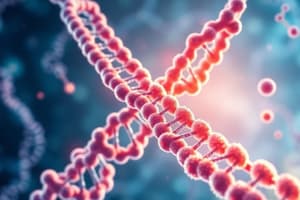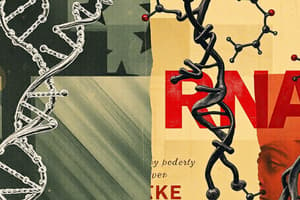Podcast
Questions and Answers
What are nucleic acids?
What are nucleic acids?
Nucleic acids are intracellular components that are required for the storage and expression of genetic information.
Which of the following are examples of nucleic acids?
Which of the following are examples of nucleic acids?
- Carbohydrates
- Proteins
- DNA (correct)
- RNA (correct)
What are nucleotides, and what are they called in relation to DNA and RNA?
What are nucleotides, and what are they called in relation to DNA and RNA?
Nucleotides are the building blocks of DNA and RNA. They are also known as the subunits of DNA and RNA.
Which of the following are purines?
Which of the following are purines?
Which of the following are pyrimidines?
Which of the following are pyrimidines?
Ribose is found in RNA.
Ribose is found in RNA.
Deoxyribose is found in DNA.
Deoxyribose is found in DNA.
What is the difference between a nucleoside and a nucleotide?
What is the difference between a nucleoside and a nucleotide?
What are the functions of nucleotides?
What are the functions of nucleotides?
What role does ATP play in cells?
What role does ATP play in cells?
What are second messengers in cell signaling?
What are second messengers in cell signaling?
What are co-enzymes, and what are some examples?
What are co-enzymes, and what are some examples?
Explain the role of UDP-glucose in glycogen synthesis.
Explain the role of UDP-glucose in glycogen synthesis.
How do CDP-choline and CDP-ethanolamine contribute to phospholipid synthesis?
How do CDP-choline and CDP-ethanolamine contribute to phospholipid synthesis?
What is the function of PAPS in sulfolipid synthesis?
What is the function of PAPS in sulfolipid synthesis?
SAM is a sulfate donor involved in reactions.
SAM is a sulfate donor involved in reactions.
What are synthetic analogues of nucleotides, and what are they used for?
What are synthetic analogues of nucleotides, and what are they used for?
How does 5-fluorouracil work as an anti-cancer agent?
How does 5-fluorouracil work as an anti-cancer agent?
What is the role of allopurinol in the treatment of gout?
What is the role of allopurinol in the treatment of gout?
Define what DNA is.
Define what DNA is.
Describe the structure of DNA in terms of its shape and components.
Describe the structure of DNA in terms of its shape and components.
What is meant by the antiparallel nature of DNA strands?
What is meant by the antiparallel nature of DNA strands?
Describe the base pairing rule (Chargaff's rule) in DNA.
Describe the base pairing rule (Chargaff's rule) in DNA.
What is the importance of the sequence of bases in DNA?
What is the importance of the sequence of bases in DNA?
How is DNA replicated?
How is DNA replicated?
What are the two main functions of DNA?
What are the two main functions of DNA?
What is RNA, and what are its key features?
What is RNA, and what are its key features?
Which of the following bases is found in RNA but not in DNA?
Which of the following bases is found in RNA but not in DNA?
How are nucleotides linked together in RNA?
How are nucleotides linked together in RNA?
Where is RNA formed, and how?
Where is RNA formed, and how?
What are the four main types of RNA?
What are the four main types of RNA?
What is mRNA, and what is its function?
What is mRNA, and what is its function?
What is rRNA, and what is its function?
What is rRNA, and what is its function?
What is tRNA, and what is its function?
What is tRNA, and what is its function?
What is snRNA, and what is its function?
What is snRNA, and what is its function?
Match each type of RNA with its primary function:
Match each type of RNA with its primary function:
Flashcards
Nucleic acid
Nucleic acid
Intracellular components storing and expressing genetic information, including DNA and RNA.
Nucleotide
Nucleotide
Building block of DNA and RNA, composed of a nitrogenous base, a pentose sugar, and a phosphate group.
Nucleoside
Nucleoside
A nitrogenous base plus a pentose sugar; a nucleotide without the phosphate group.
Purine
Purine
Signup and view all the flashcards
Pyrimidine
Pyrimidine
Signup and view all the flashcards
DNA
DNA
Signup and view all the flashcards
RNA
RNA
Signup and view all the flashcards
Double Helix
Double Helix
Signup and view all the flashcards
Base Pairing Rule
Base Pairing Rule
Signup and view all the flashcards
Phosphate group
Phosphate group
Signup and view all the flashcards
ATP
ATP
Signup and view all the flashcards
5' end
5' end
Signup and view all the flashcards
3' end
3' end
Signup and view all the flashcards
Study Notes
Mansoura National University
- Mansoura National University is a university in Egypt.
- The semester is 1.
Nucleic Acids
- Nucleic acids are intracellular components for storing and expressing genetic information
- Include DNA (deoxyribonucleic acid) and RNA (ribonucleic acid)
- Nucleic acids (DNA & RNA) are long chains of repeated nucleotides.
Learning Outcomes
- Identify nucleotides and nucleosides nomenclature and structure
- List functions of nucleotides and their biological importance.
- Recognize DNA structure
- Recognize RNA structure
- Recognize types of RNA
- Identify differences between DNA and RNA
Agenda
- Nucleotides and nucleosides (nomenclature and structure)
- Nucleotides of biological importance and their roles
- DNA (types and structure)
- RNA (types and structure)
- Structure/function relation of RNA
- Differences between DNA and RNA
Learning Outcome 1
- Identify nucleotides and nucleosides nomenclature and structure
Nucleotide Structure
- Nucleotides are the building blocks of DNA and RNA
- Each nucleotide has three parts: a nitrogenous base, a pentose sugar, and a phosphate group.
- Purines include adenine (A) and guanine (G).
- Pyrimidines include cytosine (C), thymine (T), and uracil (U).
- Ribose sugar is found in RNA.
- 2-deoxyribose sugar is found in DNA
Nucleoside
- Nucleosides are made of a nitrogenous base and a five-carbon carbohydrate (ribose).
- Nucleotides are nucleosides with an additional phosphate group.
Learning Outcome 2
- Functions of nucleotides and their biological roles
Functions of Nucleotides
- Building blocks of RNA and DNA.
- Source of energy (ATP, GTP).
- Mediating hormone action (cAMP, cGMP).
- Co-enzymes (NAD, FAD, Coenzyme A).
- Activation of chemical compounds (UDP-glucose, CDP choline, CDP-ethanolamine, PAPS, SAM).
Learning Outcome 3
- Recognize DNA structure
DNA Structure
- DNA is 2 strands of polynucleotides (d.AMP, d.GMP, d.TMP, d.CMP)
- The nucleotides are linked by 3', 5' phosphodiester bonds
- One strand of DNA has many millions of nucleotides
- DNA is a double helix, with paired strands and antiparallel orientation (one strand runs 5' to 3', the other runs 3' to 5').
- Base pairing rule (Chargaff's Rule): A pairs with T, and G pairs with C.
- DNA has a sugar phosphate backbone, within that the nitrogenous bases form hydrogen bonds.
Functions of DNA
- DNA stores and transfers genetic information and it is responsible for genetic information.
- DNA carries genetic information and is stored in the nucleotide sequence.
- DNA replicates in cell division.
- DNA directs synthesis of RNA (transcription).
The strands separate during replication
- The DNA strands separate during replication.
Structural forms of the double strand helix
- A-DNA
- B-DNA
- Z-DNA
Learning Outcome 4
- Recognize RNA structure
RNA Structure
- RNA (Ribonucleic acid) is single-stranded polynucleotides
- RNA contains four types of nucleotides: AMP, GMP, CMP, and UMP.
- The nucleotides are linked together by 3',5' phosphodiester bonds.
- RNA molecules are formed in the nucleus by transcription from DNA.
Learning Outcome 5
- Recognize types of RNA
Types of RNA
- Messenger RNA (mRNA): 5% of cellular RNA; carries messages from DNA to ribosomes for protein synthesis.
- Transfer RNA (tRNA): 15% of cellular RNA; brings amino acids to the ribosome during protein synthesis.
- Ribosomal RNA (rRNA): 80% of cellular RNA; a component of ribosomes, where protein synthesis takes place.
- Small nuclear RNA (snRNA): less than 1% of cellular RNA; involved in RNA processing.
Learning Outcome 6
- Recognize differences between DNA and RNA
Differences between DNA and RNA
| Feature | DNA | RNA |
|---|---|---|
| Site | Nucleus & mitochondria | Cytoplasm mainly |
| Function | Storage and transfer of genetic characters | Protein biosynthesis |
| Bases | A, G, C, and T | A, G, C, and U |
| Sugar | Deoxy-ribose | Ribose |
| Strands | 2 strands = double helix | One strand |
| Types | One type (3 forms: A, B, and Z) | 4 types (mRNA, tRNA, rRNA, snRNA) |
Studying That Suits You
Use AI to generate personalized quizzes and flashcards to suit your learning preferences.




